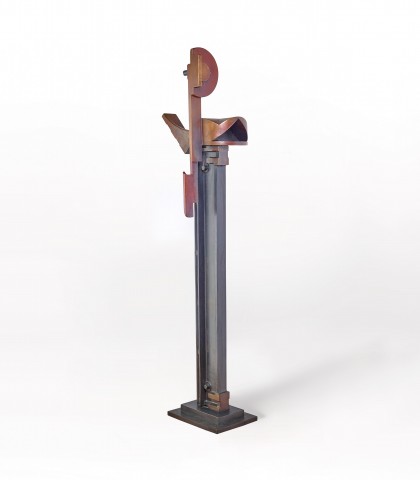No. 369, 1981
ROBERT KLIPPEL
cast 1982
bronze
201.0 cm height
signed with initials, dated and numbered on base: RK 369'81 3/6
bears Meridian foundry mark on base
Private collection, Sydney
Private collection, Melbourne
Art in the Park XI, Galerie Gmurzynska, Zurich, June – August 2013 (another example)
Gleeson, J., Robert Klippel, Bay Books, Sydney, 1983, pp. 413, 416 (illus. pl. 382), 478
Edwards, D., Robert Klippel: Catalogue Raisonné of Sculpture, (CD ROM), Deborah Edwards and the Trustees of the Art Gallery of New South Wales, Sydney, 2002 (illus. CD-ROM Artworks no. 369 b)
Edwards, D., Robert Klippel, Art Gallery of New South Wales, Sydney, 2002, p. 192 (illus.)
Wach, K., Robert Klippel - The American and European Years, Galerie Gmurzynska, Zurich, 2013, pp. 38 – 45 & 53 (illus.)
Another example of this work is held in the installation Robert Klippel, Group of Eight Bronzes, 1981 in the collection of the National Gallery of Australia, Canberra
Robert Klippel’s mantra was deceptively simple: to create; not re-create. That is, he strove to add to the world of things rather than to replicate them. In other words, he wanted to make sculpture rather than statuary.
For Klippel, true human creativity and artistic ideation inhered in the urge to emulate, even surpass, Nature’s powers of ingenuity. For Klippel, this was the crux of Modernism – the creation of new man-made additions to Nature.
It is a little-known fact that the later justly celebrated art critic Robert Hughes camped outside Sydney’s Clune Galleries so that he could get one of Klippel’s sculptures from his solo exhibition in September 1963. Such was their quality. James Gleeson AO, the Sydney artist and writer, certainly agreed with this assessment as did James Mollison AO, the far-sighted first Director of the National Gallery of Australia. In fact, Australia’s art world agreed and in 2002 he was the subject of a highly lauded retrospective exhibition, entitled Robert Klippel: A Tribute Exhibition at the Art Gallery of New South Wales, which was expertly curated by Deborah Edwards.
Perhaps nowhere is Klippel’s aesthetic prestigiousness more evident than in his Federal Government funded public sculpture commission for the opening of the National Gallery of Australia in Canberra. The present work, the bronze entitled No. 369, was created as part of this commission in preparation for the formal inauguration of the gallery by Her Majesty Queen Elizabeth II on 12 October 1982.
Klippel’s sculpture commission led to the creation and casting of a group of eight bronze works that stand in a garden pond within the NGA Sculpture Park – an informally landscaped area that includes outdoor sculptures by Auguste Rodin, Aristide Maillol, Henry Moore, Alexander Calder and Mark di Suvero – now listed by the Australian Heritage Commission on its Commonwealth National Heritage List.
Klippel was personally commissioned by Mollison and in 1981 the Group of Eight, as the cast bronze artwork came to be called, was initially constructed from sections of prefabricated wooden pattern parts that the artist had found and stored away since 1964. In 1980, one year before his NGA sculpture commission, Klippel was awarded an Australia Council for the Arts grant to investigate bronze casting techniques – the opportunity allowed him to diverge from his usual processes of fabrication to rethink and refine his growing interest in construction and reconstruction.
As a consequence, in his Group of Eight sculptures, Klippel’s use of an assemblage mode moved beyond the typical practice where disparate objects are re-arranged or re-configured into new artistic wholes. Klippel’s development from wood assemblage to bronze cast sculpture during the early to late eighties extended the parameters of reuse and recycling to an artistic form of ‘upcycling’ – where found and prefabricated objects were technically remade and materially transmuted. Bronze casting allowed Klippel to ‘push’ assemblage toward a stand-alone architectonic unity. Klippel certainly had a highly responsive and sensitive inner self, but it was never the subject of his art – like a haiku poem that reveals the wonderful perception of common things and never the personality of the poet. For Klippel, thought should always be the mother of the act.
Klippel’s Group of Eight ‘modified’ assemblage sculptures were cast in bronze by Peter Morley AM at his Meridian Foundry in Melbourne and installed as artist’s proofs, from a proposed edition of six, in the garden pond of the NGA Sculpture Park between July and October 1982 (Nos: 365, 366, 367, 368, 369, 370, 371 and 372). These were Klippel’s first major bronze sculptures – the present work firmly belongs within this notable artistic category.
KEN WACH
Associate Professor Ken Wach wrote the catalogue for the exhibition Robert Klippel: The American and European Years at Galerie Gmurzynska in Zürich in June 2013 – the first Klippel exhibition in Europe for sixty-three years. He also gave an address at the exhibition opening at the Baur au Lac Hotel. Robert Klippel is internationally represented by Galerie Gmurzynska in Zürich
